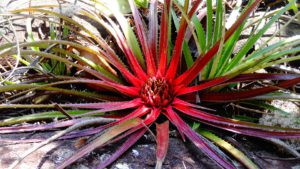Air Plant Care Guide

Air plants have an unusual appearance like they have come from another planet and will catch your eyes, these garden beauties can be grown without soil hence the name (air plant). It is also believed that air plants may only flower once during their lifetime, the good news, however, is that the pups from the parent plant can be harvested giving yet another generation. In this group or family of air plants, we get the name tillandsia, tillandsia is a genus of about 650 species of flowering plants, evergreens, and perennials that receives the majority of their nutrients from the air that circulates around them.
These species of plants come from tropical climates and are native to the Caribbean, south-eastern United States, mid-Argentina, northern Mexico, and Mesoamerica growing in deserts, forests, and mountain areas. The varieties can either be trailing, furry, spiky, or fuzzy, For more on the growth and care of tillandsia let’s take a closer look.
Watering Air Plants
There are three methods which involve watering air plants, these methods are as followed.
- Dunking
- Misting
- Soaking
Dunking Air Plants
When dunking your air plant simply place them under a tap of cold running water. The entire plant should be covered in water for about 2-3 minutes hung upside and dried before returning the plant to its location.
Misting your air plant
Misting involves the use of a spray bottle, fill the bottle with water and adjust the nozzle where the water comes out fine and misty this will ensure that your entire plant receives water. The roots and the leaves should be soaked to the point where water is dripping.
Soaking your air plant
The soaking method is the most effective on-air plants that are large or air plants which have not been given water for a while. Soak air plants by filling a container with water and submerging them for about 25-3o minutes. Remove the plant and allow to dry.
Fertilizing Air Plants
Remember as discussed earlier air plants draw nutrients from their surroundings so it is so important to give them a little help which can go a long way. Air plants that are grown in terrariums especially need some help seeing they are in a closed environment. Misting the leaves of your air plant with a water-soluble or quick-release will help. Fertilizers that are labeled for bromeliads or air plants will help greatly, fertilize once or twice a month or according to the manufacturer’s directions.
Garden insect pests of air plants
Air plants do have some uninvited guess but taking quick action by bringing them under control will keep your air plants healthy, these bugs are.

- Mealybugs
- Aphids
- Chiggers
Mealybugs
Mealybugs are tiny white insect which is coated or covered in a mealy wax substance, these garden insect pests cause injury by sucking sap or fluids from garden plants. Mealybugs can be brought under control with the use of insecticidal soap, diatomaceous earth, or other pesticides that are labeled for air plants.
Aphids
Aphids are a tiny pear-shaped insect that is generally light green but can be other colors as well. These garden insect pests are among the easiest of pests to eliminate. Aphids can be controlled by wiping the leaves with a damp cloth, knocking them off your plant with a strong spray of water, or the use of pesticides that are listed for their control.
Chiggers
Chiggers are red mites that are hard to spot because of how tiny they are. The use of a magnifying glass will help or if they are in a cluster may be spotted more easily, these bugs are known to attach themselves to humans. Chigger bugs once attached to the skin will use their mouth to bite, injecting fluids, and will partially dissolve tissues causing redness itching, and blisters. Some persons have an allergic reaction, chiggers will also prey on animals. A multipurpose insect killer is recommended to bring chiggers under control.
Diseases of air plants
It is a known fact that tillandsia is not susceptible to disease, if your plants are showing signs that something is going on, for example, the leaves turn yellow and start to wither may be because of poor storage before being purchased. The environment plays a big role and will affect how these plants respond.
When purchasing avoid plants that show the above symptoms along with plant parts and leaves which are dry. Air plants should never be exposed to temperatures below 12 degrees.
Growing air plants outdoors
Below are a few places to grow air plants outdoors.
1. Attach air plants to tree trunks.
2. Let air plants hung from your tree limb and branches,
3. Install them in containers and place the containers on a table that’s outdoors.
4. Let air plants hung from your outdoor ceiling.
5. Install larger air plants in containers and place the container on either side of your door entrance.
6. Place air plants in a container or globe and place the globe on the breakfast counter that is either in or outdoors.
Placing air plants indoors
1. Place air plants around the base of your house plants.
2. Place air plants on a shelf that gets medium to low light.
3. Air plants can be placed between the leaves of your house plant.
4. Install them on your windowsill.
5. Find a spot on your bookcase.
6. What about your kitchen counter?
7. Your coffee table may be the perfect spot.
8. A brewer draw makes a cozy spot.
Growing Air Plants in Globes
When growing and caring for air plants that are in a globe ensure that the globe is medium to large which will give the plant the room that it needs. Before installing your air plant in the globe soak in a container of water for about 30 minutes. Allow your air plant to dry before placing it in the globe, when placing your globe locate an area that gets low to moderate light. Misting your air plant is so important, 4-5 times per week will give good results however if your air plant is receiving too much moisture it will die so pay close attention and monitor the extent of the dryness before misting.
Caring for air plant pups
To remove the pup from the mother plant hold both the mother and the pup firmly and apply a little pressure to the pup pulling in the downward position or using a sharp knife or pruner and cutting as close to the parent as possible. Again cutting in a downward position will give good results.
Some Species of Air Plants
Below are just a few names of air plant species.
1. Spanish Moss.
2. Small Ballmoss.
3. Tillandsia maxima.
4. Tillandsia ionantha.
5. Tillandsia brachycaulos.
6.Tillandsia cyanea.
7. Tillandsia brachycaulos.
8. Tillandsia ionantha Guatemalan.
9. Tillandsia ionantha Mexican.
10. Tillandsia funkiana
final word
Air plants can be installed both in and outdoors, this family is so huge so you have so many to choose from. Air plants are easy to maintain and you can grow them literally anywhere, this method of growing and caring for plants is very popular and enjoyed by many. Give it a try I am sure that you will be so happy that you did.
About the author
Norman loves being in the garden, both at home and for his job....
he is 'Natures Little helper' being outdoors, growing his vegetables and flowers from an early age.
Now having spent over 22 years in the profession he want to give some of his knowledge to others...
his vast array of hints and tips you will find scattered over this site will help you no end growing plants in your garden.

I only recently came across air plants. I had no idea whatsoever how to even add them to my garden. I have heard some encouraging things about them though and that has prompted me to take a closer look. I have to say, you have clarified it in a very detailed manner. It is particularly intriguing to learn that it can be installed indoor as well as outdoor. Thanks for sharing
It is so good to meet you and I am so happy that I could help. Air plants are truly amazing and will work wonders.
I found this article very informative and educational. Although I have seen plants growing out of tree trunks, I hadn’t seen them attached to ropes. This was fascinating. The variety of plants varying in shapes and colors makes this a great option to create plant color in the home.
The methods of watering the plants seemed reasonable and do not appear time consuming. Is it possible to set up a drip system or other means of automating the watering process? I ask this because if one builds up a large collection it could become very time consuming watering all the plants manually.
Thanks for writing this fascinating article.
Edwin
The air plant family is so amazing and can work wonders. Yes if that is the way to go then it is possible to have a system installation that will help.
Hello there,thanks for this awesome article I know it would of help to the public as it has been of help to me… because bit very informative and interesting too.air plants are one of God’s gift to man as they are very unique I had some these species in my garden and I tell you they are very nice but I didn’t have time to take good care for them so everything was messed up.thanks once more for the tips as I would use them once I restart my garden.
Yes, these plants are God’s gift and they are so easy to care for. I am so happy that could help.